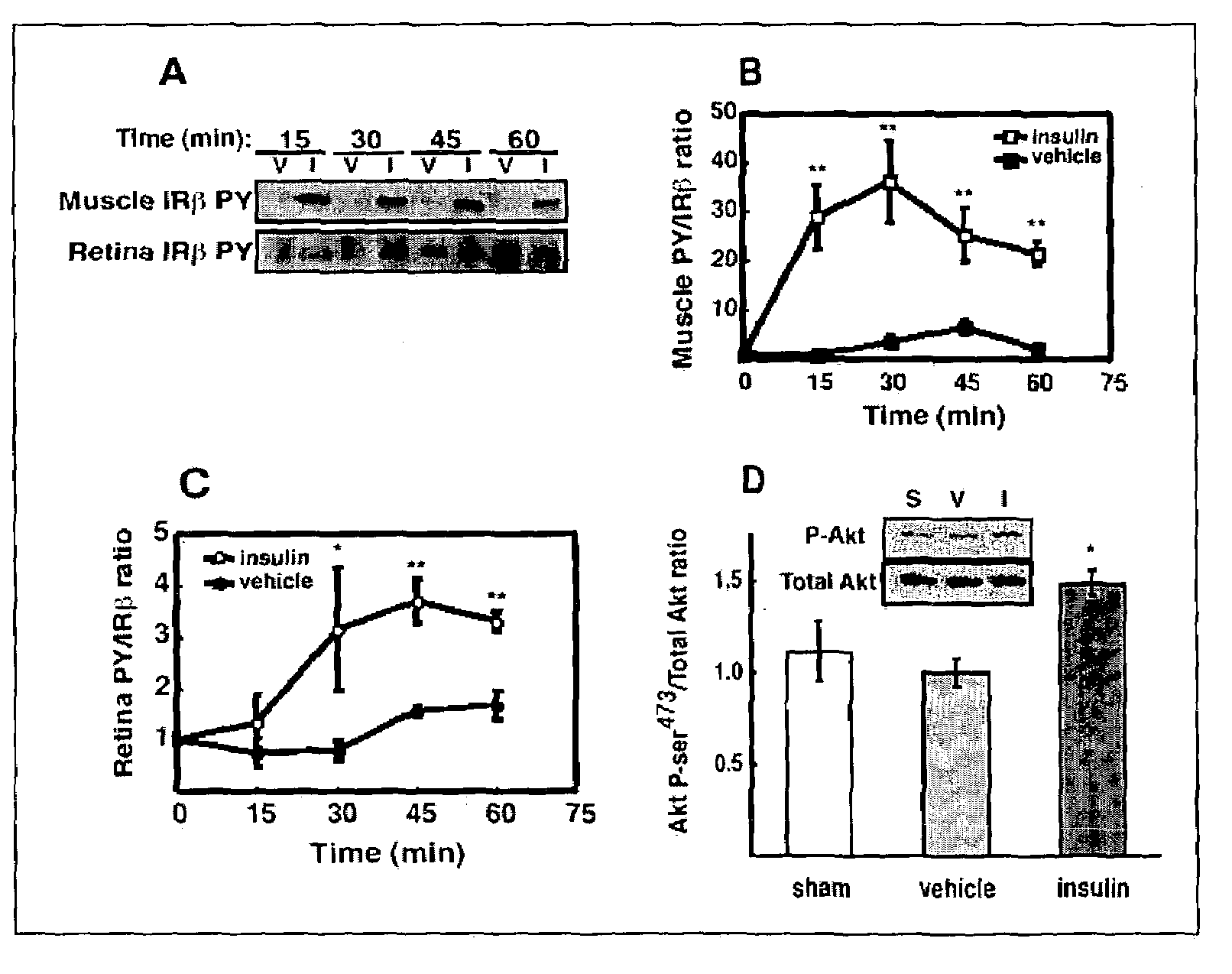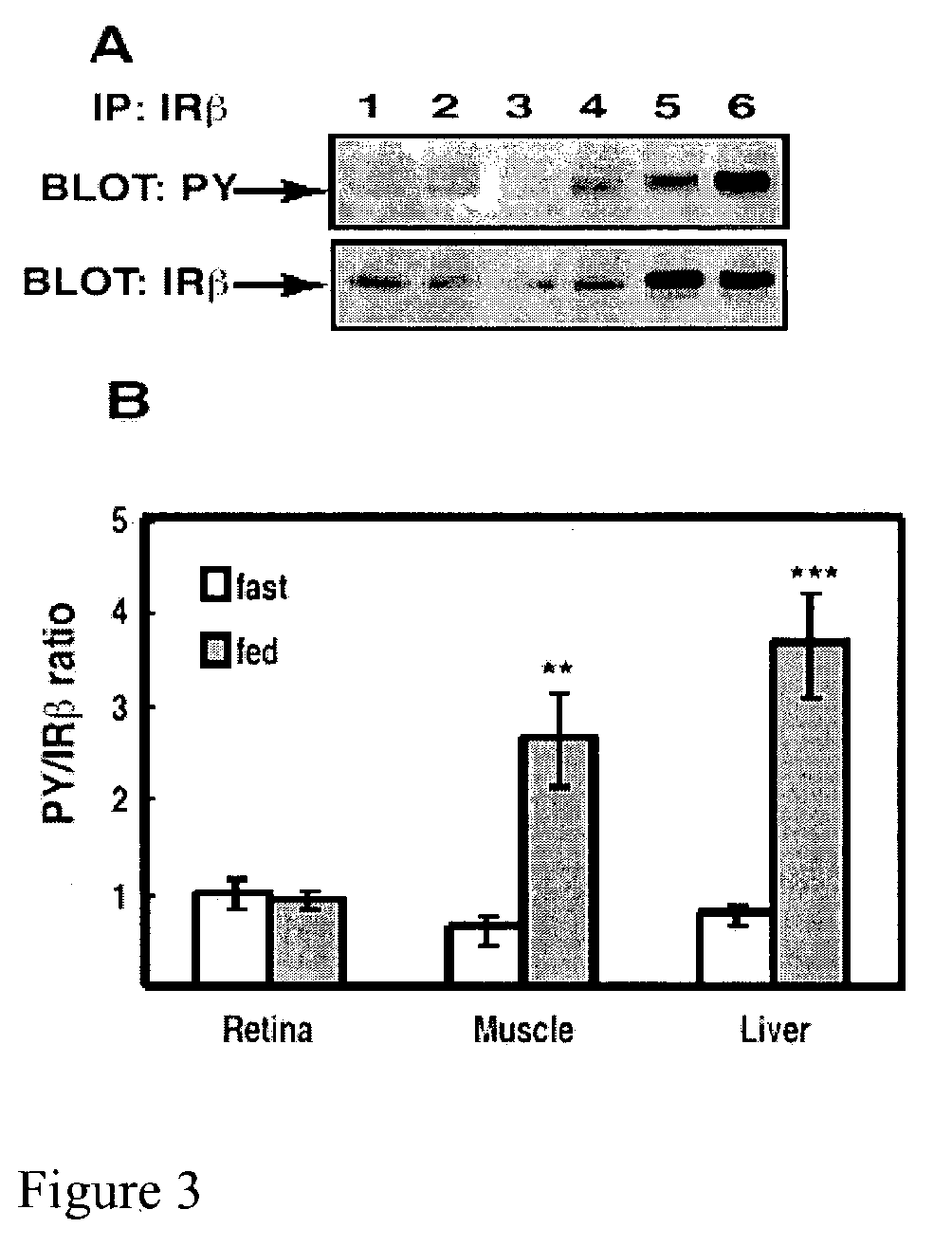Periocular drug delivery for diabetic retinopathy
a diabetic retinopathy and periocular drug technology, applied in the direction of extracellular fluid disorder, prosthesis, metabolic disorder, etc., can solve the problems of macular edema, blurred vision, vessels can bleed, etc., to maintain retinal cell function and survival, and achieve safe and effective
- Summary
- Abstract
- Description
- Claims
- Application Information
AI Technical Summary
Benefits of technology
Problems solved by technology
Method used
Image
Examples
example 1
[0038]Intraportal insulin injection was performed to determine if a single bolus insulin injection, and therefore an acute elevation in circulating insulin, could activate retinal insulin receptors (IR) in vivo as it does in other tissues. Intraportal insulin injection was conducted as follows. Male Sprague-Dawley rats (Charles River, Mass.) weighing 200–350 g were fasted 18 hours prior to being anesthetized with a 10:1 ketamine:xylazine cocktail (53.5 mg / kg ketamine and 5.33 mg / kg xylazine) administered by intramuscular injection. The fasted rats were administered a 500 μg bolus of insulin, nothing (sham), or vehicle (0.9% saline) via the portal vein. At 15, 30, 45 and 60 minutes post injection (shown in FIG. 2A), hindquarter skeletal muscle and retina were snap-frozen under liquid nitrogen, and then stored at −80° C. pending analysis by immunoprecipitation and immunoblotting. There was no difference in insulin receptor beta-subunit (IRβ) phosphorylation between vehicle (V) and ins...
example 2
[0045]Tyrosine phosphorylation in retinal IRβ and changes therein was compared with other insulin responsive tissues under freely fed and moderately fasted conditions as follows.
[0046]Six male Sprague-Dawley rats (Charles River) were fasted (18 hours) and were compared to 6 rats that were freely fed overnight. All rats weighed 200–350 g and were anesthetized with a 10:1 ketamine:xylazine cocktail as described in Example 1. Upon loss of motor reflex in the rats' retina, tissue samples from liver and hindquarter skeletal muscle were obtained, homogenized and immunoprecipitated as described in Example 1 and then subjected to Western blot analysis, also as described in Example 1. The blot in FIG. 3A shows that IRβ phosphorylation was unaltered in retina, but increased in muscle and liver compared to fasted rats. Phosphotyrosine-probed immunoblots were then reprobed for total IRβ content with the immunoprecipitating antibody as described in Example 1 to normalize the Western blot data.
[0...
example 3
[0049]Because tyrosine phosphorylation of the IR does not directly measure enzymatic activity, an IR kinase assay was developed.
[0050]The IRβ from fasted and fed rats was immunoprecipitated from retina and liver and analyzed by PY immunoblotting for autophosphorylation with (+) and without (−) the addition of ATP to the kinase reaction. IRβ immunoprecipitates obtained as described in Example 2 were subjected to IR kinase assays as follows. The Sepharose bead complex, obtained as described in Example 1, was washed three times with 200 μL of kinase buffer (50 mM HEPES, pH 7.3, 150 mM NaCl, 20 mM MgCl2, 2 mM MnCl2, 0.05% bovine serum albumin, and 0.1% Triton X-100). Western blotting was performed on these immunoprecipitates as described in Example 1; the results of these Western blot experiments (shown below) showed that washing the Sepharose bead / immune complex in kinase buffer did not diminish total bound IRβ. After the last (third) aspiration of kinase buffer, 500 μL of kinase buffe...
PUM
| Property | Measurement | Unit |
|---|---|---|
| volume | aaaaa | aaaaa |
| volume | aaaaa | aaaaa |
| volumes | aaaaa | aaaaa |
Abstract
Description
Claims
Application Information
 Login to View More
Login to View More - R&D
- Intellectual Property
- Life Sciences
- Materials
- Tech Scout
- Unparalleled Data Quality
- Higher Quality Content
- 60% Fewer Hallucinations
Browse by: Latest US Patents, China's latest patents, Technical Efficacy Thesaurus, Application Domain, Technology Topic, Popular Technical Reports.
© 2025 PatSnap. All rights reserved.Legal|Privacy policy|Modern Slavery Act Transparency Statement|Sitemap|About US| Contact US: help@patsnap.com



